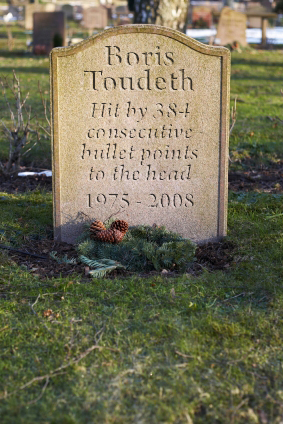
Rest in peace, Boris Toudeth (c)iStockPhoto/Arvid Emtegren
Has your life been threatened by bad PowerPoint presentations? Maybe a recent presentation stole 30-60 minutes of your life which you would like back. Unfortunately, too many of us have sat through an experience known as “death by PowerPoint” – a disinterested presenter, a series of disconnected slides, a merciless procession of bullet points, and a mishmash of overly complex clip art, charts, and tables. Sound painfully familiar?
PowerPoint is one of the most maligned business tools in the media. Professor Edward Tufte declared “PowerPoint is Evil” in a popular Wired article. Several Dilbert comics have mocked ineffective presentations in the workplace, including “PowerPoint poisoning”. But is PowerPoint software really to blame? If someone driving a pick-up truck ran over my dog, would I blame the careless driver or the car they drove? Some people may argue that PowerPoint’s combination of ease of use and advanced multimedia features is akin to handing out car keys to five-year olds. For public safety reasons, we may wish presenters were required to obtain some sort of PowerPoint license, but we can’t blame the software for the abuse by its users.
Rather than prescribing arbitrary, rigid list of rules for your slides so you can avoid “death by PowerPoint” (e.g., no more than 7 bullet points per slide, never read from your slides, don’t use more than three fonts, etc.), I’m going to focus on something different in this article. What are the factors that typically cause everyday presenters to end up in these unfortunate situations?
- Lack of preparation
- Lack of experience or knowledge
- Indifference
- Self-importance
Lack of preparation: Failing to properly prepare is one of the biggest contributors to bad presentations. Frequently you have less than a week to prepare a presentation. Even if you receive several weeks notice, you can’t devote all of your time to building PowerPoint slides. In the rush to prepare your slides, you may skip important steps such as identifying a core message, simplifying your content, or rehearsing your slides, which would have significantly enhanced your final product. Poor time management can also ruin presentations. If you burn several hours on one or two slides, you may rush through the rest of your slides and not have enough time left over to do them justice. The more time and effort you put into preparing your presentation, the more your audience will likely get from it.
Lack of experience or knowledge: If you remember your first presentation experience, you probably committed some mistakes and learned several memorable lessons. Many inexperienced presenters lack confidence. They try to prove themselves by covering a lot of material in their slides, but in the process they end up losing their audiences. On the other hand, experience isn’t always a guarantee for presentation success. Seasoned presenters may adhere to bad PowerPoint habits picked up from the prevailing conventions within their companies and industries. If these presenters are complacent with the status quo, “death by PowerPoint” moments will persist. If you’re a novice presenter, run through your presentation with colleagues to get feedback. If you’re an experienced presenter, keep an open mind and explore new ways of enhancing your skills via presentation courses, books, or blogs.
In my next post, I will cover the two remaining factors of indifference and self-importance as well as provide a list of important questions to ask yourself before your next presentation.

